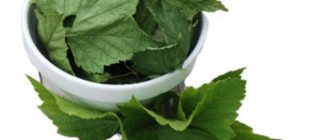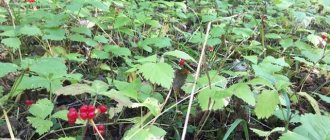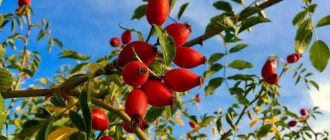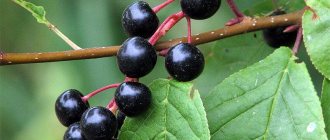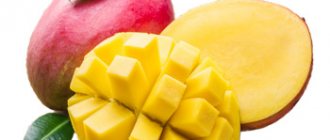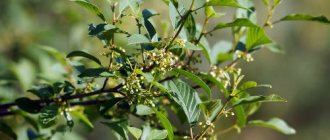Blueberries are the “queen” of northern latitudes. It includes about 100 species of various blueberry bushes and trees. Its distribution area is very wide: it grows in the forest-tundra, taiga, coniferous forests and sphagnum swamps of Europe and Asia, in the Caucasus mountains. The common blueberry, or myrtle-leaved blueberry, is the most common species of this genus. The largest variety of blueberry is a tree growing in the Caucasus mountains - Caucasian blueberry. This tree can reach up to 3 m in height, and its fruits do not have the same coloring properties as blueberries. Blueberries also grow in the forests of North America, but even there they are of Eurasian origin.
What does a common blueberry look like? This is a low-growing shrub that rarely reaches even half a meter in height. The blueberry bush blooms in late May–June, and the fruits ripen by the end of July–August. Its berries are round in shape, up to 8 mm in diameter, and are dark blue with a bluish tinge. The taste of the berries is sweet with pleasant sourness and a slight tartness.
All about the composition of blueberries
Content:
- All about the composition of blueberries
- Beneficial features
- Home remedies
- Dietary supplements and cosmetics
- Hazardous properties
- Use in cooking
- Preparation of blueberries
- Interesting things about blueberries
- conclusions
The benefits of blueberries have been known since time immemorial. The history of the use of blueberries in Rus' dates back to pagan times. It has always been a revered healing agent of shamans and healers. They endowed it with miraculous properties, based on their many years of experience.
The use of blueberries in modern medicine is based on the laboratory-established chemical composition of the berries and the proven effect of the detected substances on the functions of various human organs.
For example, to find out whether blueberries lower or increase blood pressure, a clinical study was conducted in which 80 patients took part. For eight weeks, they drank 1 glass of the juice of these berries twice a day. At the end of the experiment, it turned out that all participants' blood pressure levels decreased.
Why and how is this berry useful? The value of these wild berries lies in their unique composition. The fruits of blueberry bushes contain:
- tannins (gallocatechin, epicatechin, epigallocatechin);
- organic acids (gallic, acetic, tartaric, malic, citric, succinic, quinic, benzoic, lactic, oxalic);
- mono- and polysaccharides (glucose, fructose, sucrose, fiber, pectin);
- fatty acid;
- proteins and amino acids;
- flavonoids and antioxidants (anthocyanins, catechins, leukoanthocyanins, saponins);
- vitamins and vitamin-like substances (ascorbic acid, carotene, B vitamins, rutin);
- macro- and microelements (sodium, potassium, calcium, magnesium, phosphorus, iron, manganese, iodine, chlorine, sulfur).
The calorie content of blueberries is low: 100 g of berries contains 44 kcal. The low calorie content of berries makes it possible to include it in various diets.
In addition to berries, many useful substances are contained in the shoots, leaves and stems of blueberry bushes, so they are also successfully used to make a variety of therapeutic and prophylactic products.
The tannins contained in blueberries belong to the pyrocatechol group. Their high content in berries determines the astringent properties of blueberries. Getting on mucous membranes and wound surfaces, tannins cause partial coagulation of proteins, which leads to their drying and the formation of a protective film on their surface. The concentration of tannins increases in dry berries.
When consuming products containing organic acids, putrefactive and fermentation processes in the intestine are suppressed, as a result of which its own microflora is normalized. They are actively involved in various metabolic processes, due to which they normalize metabolism in the human body. Many organic acids stimulate the secretion of the salivary and other digestive glands and affect the acid-base balance. Some acids have antiseptic and antimicrobial properties.
Simple carbohydrates (glucose, fructose, sucrose) have energy properties, affect the speed of nerve impulses, and participate in the synthesis of cells and tissues of the body. An indigestible polysaccharide - cellulose (fiber) has a number of beneficial properties for the human body:
- absorbs (accumulates) toxic substances from the intestines, thus cleansing the intestines;
- reduces the rate of absorption of simple carbohydrates and cholesterol, which helps reduce their levels in the blood;
- retains water in the intestines, as a result of which the volume of its contents increases and the motility of the intestinal walls is stimulated.
Blueberries contain pectin, which has the ability to bind heavy metal salts and free radicals, which has a detoxifying effect on the body.
The fatty acids contained in blueberry juice are essential. They are represented mainly by mono- and polyunsaturated omega-3 fatty acids, which:
- improve the rheological properties of blood: reduce viscosity, increase blood fluidity;
- have an antioxidant effect;
- reduce the concentration of cholesterol in the blood;
- have hypotensive and anti-inflammatory effects.
The proteins contained in blueberries are sources of essential amino acids in the human body (leucine, isoleucine, valine, phenylalanine).
Blueberry anthocyanin flavonoids (neomirtillin, myrtillin, arbutin) have a hypoglycemic effect, which allows the berries to be consumed by diabetes mellitus and included in various antidiabetic preparations. Arbutin exhibits its antiseptic and antimicrobial properties in an alkaline environment, which is urine in various inflammatory diseases of the urinary system.
Anthocyanins, catechins and leukoanthocyanins are powerful antioxidants and angioprotectors, therefore they are good at restoring impaired microcirculation in tissues, in particular in the eye structures. The scientific literature contains information about the preventive anticancer effect of antioxidants in blueberry extract. Similar antioxidants are also found in blackberries, blue grapes, radishes, and red apples, but the leader in their concentration belongs to blueberries.
The fruits of the blueberry bush are rich in saponins, which have many beneficial therapeutic effects (mucolytic, diuretic, hypocholesterolemic, sedative), and also facilitate the absorption of certain medications when taken simultaneously.
Vitamins and minerals of berries have an immunostimulating effect, normalize metabolism, increase visual acuity, and restore the electrolyte balance of body fluids.
Rich composition
Blueberries have a very rich vitamin and mineral composition. Blueberries per 100 g contain 86.5 g of water, 1.1 g of proteins, 8.6 g of carbohydrates, 2.2 g of dietary fiber, 1.2 g of free organic acids; 51 mg potassium, 6 mg sodium, 16 mg calcium, 6 mg magnesium, 13 mg phosphorus, 7.0 mg iron, 0.9 mg copper, manganese, cobalt, nickel; 0.01 - 0.02 mg of vitamins B1 and B6, 0.30 mg of vitamin PP, 10 mg of vitamin C, some amounts of vitamin P, pantothenic acid.
Why I love my robot vacuum cleaner so much: sharing my own experience
Beneficial features
The health benefits of natural blueberries are undeniable. The unique balanced chemical composition of blueberry fruits, shoots and leaves determines a wide range of beneficial properties of this plant. These include:
- antibacterial;
- antiseptic;
- anti-inflammatory (suppresses foci of inflammation);
- immunomodulatory (stimulates the immune system);
- hypocholesterolemic (lowers cholesterol in the blood);
- hypoglycemic (reduces blood glucose levels);
- hypotensive (reduces blood pressure);
- mucolytic (thin the sputum);
- astringents (dries the wound surface);
- antioxidant (prevents lipid peroxidation and cell damage by free radicals);
- hepatoprotective (protects liver cells);
- angioprotective (protects vascular walls);
- improving microcirculation in tissues;
- hematopoietic (increases the level of hemoglobin in the blood);
- anti-burn;
- wound healing;
- sedatives.
This range of beneficial properties makes it possible to use blueberries or products made from them internally as one of the means of complex treatment:
- eye diseases (cataracts, night blindness, uveitis, retinopathy);
- diseases of the cardiovascular system (atherosclerosis, arterial hypertension, coronary heart disease, thrombosis, varicose veins);
- iron deficiency anemia;
- metabolic disorders (type 2 diabetes mellitus, gout, obesity);
- neurological pathologies (senile dementia, Alzheimer's disease);
- inflammation of the oral cavity and pharynx (stomatitis, gingivitis, tonsillitis);
- kidney diseases (urolithiasis, chronic pyelonephritis and glomerulonephritis);
- diseases of the digestive tract (stomach, intestines, liver and pancreas).
Blueberries have an effective effect on stool. At the same time, you need to know how to eat the berries so that they have the desired effect. Whether blueberries will strengthen or weaken depends on the method of harvesting the raw materials:
- fresh berries are indicated for constipation, as they increase intestinal motility;
- dried berries help against diarrhea because they reduce intestinal motility.
External use of products containing blueberry raw materials is indicated for:
- inflammatory processes on the skin;
- age-related changes in the skin (aging, sagging, aging skin);
- scarring changes on the skin;
- varicose veins;
- hyperpigmentation.
Regular consumption of blueberries has been proven to help against cancer (reduces the incidence of blood, breast and colon cancer) due to their high antioxidant content.
The Pledge of Eternal Youth
One of the main benefits of blueberries is anthocyanin. This is a plant substance from the group of flavonoids. The berry owes its deep blue color to it. But for humans, the benefit of anthocyanin lies in its powerful antioxidant effect. In simple terms, it provides blueberries with the ability to remove waste and toxins from the body, which accelerate the aging process. The conclusion suggests itself: more blueberries - longer youth.
This fact has been scientifically confirmed by scientists at the Boston University Food Research Center. After conducting tests, the researchers were pleasantly surprised by the results obtained: the berry, unpretentious to growing conditions, is capable of triggering processes that significantly slow down the aging of the body and have a rejuvenating effect. The head of the research, by the way, himself became an avid lover of blueberries and regularly eats them for breakfast.
It’s not for nothing that blueberries are often called a rejuvenating berry. Her passionate fans are distinguished by clear skin, shiny hair and an invariably cheerful mood. And why shouldn’t they shine! By constantly including fresh blueberries or dishes made from them in the menu, they ensure a regular supply of vitamin C, which is responsible for the production and action of collagen, which is responsible for the absence of wrinkles and the general condition of the skin.
But the effect of wild berries on the body is not limited to just the external rejuvenating effect. Scientists have proven that regular consumption of blueberries slows down the natural decline of cognitive ability in older people and also improves short-term memory.
Home remedies
Fresh berries can be used as a home remedy. It has been established by evidence that for adult eye health, the norm is to consume 50-150 mg of anthocyanins from food every day. This amount of these substances is contained in 15-20 g of fresh blueberries. Exceeding this daily amount does not increase the effect, but the likelihood of side effects, for example, darkening of tooth enamel, increases.
You can make eye drops from the juice of fresh berries. To prepare them, you need to mash 2 tablespoons of fruits in a porcelain bowl to obtain juice. The juice is filtered through cheesecloth or a fine sieve to remove seeds and diluted with sterile distilled water purchased at a pharmacy in a ratio of 1:2. The prepared solution must be poured into a boiled bottle. Keep refrigerated. These drops are used for diseases of the cornea or conjunctiva, instilling 2-4 drops of blueberry solution into each eye daily.
The juice of fresh berries can be used to make compresses on the skin for wounds or burns. The procedure should be performed daily at least three times a day.
You can make a compress from dried berries, similar to a compress from the juice of fresh berries. A blueberry extract is prepared for it: 100 g of dried berries are poured into 0.5 liters of boiling water, wrapped in a towel and left for half an hour, after which the infusion is boiled. After cooling, the broth is filtered and used for compresses.
When you have a cold and to strengthen your immune system, you can brew healthy blueberry tea, which can successfully replace regular black or green tea in the cold season. How to brew blueberry tea so that it remains healthy? To prepare it, pour 100 g of dried berries or leaves with one liter of water at room temperature, put on low heat and cook after boiling for 10 minutes. After this, the broth is wrapped and infused for half an hour. The drink turns out aromatic and healthy. To normalize sleep, you can drink this tea before bed with honey or mint.
Folk recipes
Blueberries are very useful for normalizing the activity of the gastrointestinal tract. As a means of normalizing metabolism, take fresh blueberries in large quantities.
The beneficial properties of blueberries for diarrhea are to eat several pieces of dried or fresh berries at short intervals.
For indigestion, diarrhea and chronic constipation: mash 2 teaspoons of blueberries and pour 1 glass of boiling water, leave, wrapped, for 3 hours. Use this infusion to gargle and gargle in the treatment of catarrhal tonsillitis and acute tonsillar tonsillitis. Drink 1/2 cup 4 times a day warm, for children - from 1 teaspoon per dose to 1/4 cup. The same infusion is used in the treatment of pneumonia and pulmonary tuberculosis.
For weeping eczema, burns and other skin diseases, freshly brewed blueberries in mashed form are used in compresses and lotions.
The healing properties of blueberries for gout, rheumatism and other diseases associated with metabolic disorders: pour 1 - 2 teaspoons of blueberries with 1 glass of boiling water, leave, wrapped, 3 - 4 hours, sweeten. Take 1/4 cup 5-6 times a day.
Dietary supplements and cosmetics
The beneficial properties of blueberry raw materials are used by pharmaceutical manufacturers to produce all kinds of biologically active additives (dietary supplements). Biological products containing blueberry plant raw materials are intended for different groups of potential consumers and, as a rule, have a “narrow specialization”:
- for women (normalize the menstrual cycle, stimulate the female reproductive system);
- for men (increase potency, improve sperm quality);
- for pregnant women (reduce blood sugar levels, dull the feeling of hunger, increase hemoglobin in the blood);
- for diabetics (have a hypoglycemic and diuretic effect, strengthen the walls of blood vessels in the eyes and kidneys, reduce blood cholesterol levels in diabetes);
- for immunity (enrich the body with vitamins, minerals and antioxidants);
- for vision (improves microcirculation in the vessels of the retina, heals microtraumas of the cornea, saturates the body with “visual” vitamins A and );
- for blood (thin the blood, stimulate hemoglobin synthesis);
- for memory and normalization of sleep (improves cerebral circulation, slows down the aging process of neurons);
- for the heart (lower blood pressure, protect myocardial cells from damage by free radicals);
- for blood vessels (strengthens the walls of blood vessels, reduces cholesterol levels in the blood, prevents thrombosis);
- for weight loss (enrich the body with vitamins and minerals, normalize stool during a diet).
For ease of use and dosage when taken orally, dietary supplements are available in the form of:
- blueberry tablets;
- capsules;
- dragee;
- syrups;
- extracts;
- concentrates;
- herbal teas
To enhance the effect of the beneficial substances of blueberries, minerals, vitamins, fatty acids and other beneficial substances are additionally added to the preparations.
Preparations with blueberries that are popular on the modern dietary supplement market include:
- “Evalar blueberry forte with zinc”;
- “Strix forte”;
- “Visivit”;
- “Doppelhertz active with lutein and blueberries”;
- “VIS blueberry extract”;
- “Flax fiber with blueberries”;
- dragee “Tentorium blueberry”;
- herbal tea “Gluconorm with blueberries”.
The composition of these products differs depending on the age, gender, physiological state of the consumer and the purpose of their use. How to drink these products so that they have a positive effect and do not cause poisoning, you must read the instructions attached to them. To be sure of the authenticity of these products, they must be purchased at a pharmacy.
Blueberries are also popular among cosmetics manufacturers. In the cosmetic field, based on substances obtained from blueberry raw materials, cosmetics are produced for the face, for the skin around the eyes, and for hair. These are all kinds of serums, oils, creams, masks, soaps, shower gels, shampoos for different skin and hair types. Most often, these products, in addition to substances from blueberry raw materials, contain additional components that are designed to enhance the effect of blueberries (for example, blueberry cream with hyaluronic acid and collagen for mature skin).
This demand for blueberries in cosmetics is explained by their ability to:
- relieve inflammation;
- regenerate skin;
- improve skin microcirculation;
- normalize lymphatic drainage from subcutaneous fat;
- soften and nourish the skin.
In addition to cosmetic products for hair and skin care, the beneficial properties of blueberries are also used by manufacturers of decorative cosmetics (for example, the use of blueberry seed oil in the production of lipstick).
What's the use
Blueberries are very useful for anemia, kidney stones, gout, rheumatism, and skin diseases.
In folk medicine, blueberries are used for sore throat, kidney stones, gout, and rheumatism.
In terms of manganese content, blueberries surpass all other berries, fruits and vegetables. Blueberries also contain vitamins C, B1, B2, carotene, tannins, pectins, sugars (5-6%), malic, quinic, succinic and lactic acids. Blueberries are widely used for diseases of the gastrointestinal tract, gastritis with low acidity, intestinal infections, hepatitis, anemia, kidney stones, gout, rheumatism, and skin diseases.
Since blueberries improve vision, they are recommended for people whose profession requires good vision. Blueberries reduce blood sugar levels and are therefore beneficial for diabetes. Long-term consumption of fresh blueberries helps with constipation.
As we said above, blueberries have powerful antimicrobial properties, because blueberry phytoncides have a detrimental effect on dysentery bacillus, staphylococci, pathogens of dysentery, and typhoid fever. Therefore, while it’s summer and blueberry season, you need to eat plenty of blueberries every day. Eat with anything, as long as the berries are fresh.
Of course, the beneficial properties of blueberries do not end there. Continuing the conversation, important properties for the eyes should be noted. You definitely need to know that blueberries significantly improve human vision, accelerate the renewal of the retina, enhance visual acuity, provide a field of view, and reduce eye fatigue during any work, especially at dusk, at night and under artificial lighting.
Hazardous properties
Before using dietary supplements or other products containing blueberry raw materials, you should consult your doctor about the possibility of their use. Contraindications for consuming blueberries and products made from them are:
- individual intolerance (can manifest itself in the form of nausea, vomiting, diarrhea, allergies);
- allergic reactions in the patient's history (rash, itching, urticaria);
- simultaneous intake with vitamin C or foods containing it in large quantities - raspberries, wild strawberries, strawberries (benzoic acid contained in blueberries, when interacting with ascorbic acid, forms a carcinogen);
- urolithiasis, gout (oxalic acid can increase oxaluria - an increase in the concentration of oxalic acid in the urine, which leads to the formation of oxalate stones);
- acute pancreatitis (increased secretion of the pancreatic glands can worsen the patient’s condition with pancreatitis);
- acute cholecystitis and exacerbation of cholelithiasis (increased motility of the smooth muscles of the gallbladder and ducts, together with an increase in the secretory function of liver cells, can lead to blockage of the bile ducts with stones);
- hyperacid gastritis and peptic ulcer (blueberries increase the acidity of gastric juice, therefore they are prohibited for consumption with gastritis with high acidity and with peptic ulcer).
To avoid side effects of blueberry products, it is necessary to limit its consumption during pregnancy. It should not be given to infants and children under one year of age.
Women who are breastfeeding (BF) should consume blueberries with great caution, especially in the first month of breastfeeding. Taking blueberries by a nursing mother during breastfeeding can lead to allergic reactions or digestive disorders in the child. Therefore, the question of whether blueberries can be consumed by nursing mothers or not should be decided by the doctor after studying the instructions for the drug.
The instructions for use of the drug must include:
- description of the composition;
- characteristics of its effect on the body;
- method of administration and dosage;
- precautions;
- indications and contraindications;
- best before date;
- manufacturer and his contact details;
- information on state registration of the drug.
From the instructions for the drug you can also find out at what age the drug can be given to children.
If for any reason there are no instructions for use or if it contains incomplete information, you should never take such a drug.
Dietary properties
Blueberries have powerful dietary properties. Blueberries are very low in calories. The required daily serving of blueberries (a small bowl) contains only about 40 calories, but provides the body with plenty of vitamins and minerals, especially vitamin C, potassium and iron. Each serving of blueberries contains as much fiber as a piece of brown bread. Frozen blueberries can be stored in the refrigerator for a long time and used as an additive to porridge and as an independent treat.
Article protected by copyright and related rights. When using or reprinting material, an active link to the women's website www.inmoment.ru is required!
Tags: blueberries
Use in cooking
The taste qualities of blueberries allow them to be used in cooking for preparing various dishes:
- sweet soups;
- gravy and sauces for meat;
- desserts;
- compotes and jelly.
Every housewife can easily find something to make from blueberries to please her household.
The healthiest thing to do is start every morning with oatmeal and blueberries. To prepare it, you need to bring the milk to a boil, add oatmeal and sugar to taste. You need to cook the porridge for 5 minutes over low heat, stirring constantly. At the end of cooking, add butter and stir. Place the finished porridge on a plate and sprinkle with fresh or frozen blueberries. This breakfast strengthens the immune system and increases vitality.
Blueberry jelly will help enrich the body with vitamins, minerals and antioxidants and improve digestion. To prepare it you need to take:
- a glass of blueberries (fresh or frozen);
- 200 g sugar;
- 3 tablespoons starch;
- 2 liters of water.
Place the berries in a saucepan with water, add sugar, stir and put on high heat. While the broth is boiling, you need to dilute the starch in water. After boiling, the compote needs to be cooked for about 15 minutes, then strain. The strained compote should be brought to a boil, then pour the diluted starch into it. Stirring, bring the jelly to a boil and cook over medium heat for 2-3 minutes.
Daily norm
The benefits and harms of blueberries appear depending on their dosage. If you eat more than normal, complications will arise. To prevent this, adults should eat no more than 25 grams of fresh berries per day. This is two tablespoons. For children under two years old, it is better to first give them a couple of crushed berries. After two years, it is allowed to introduce up to 15 g of the product into the diet. Upon reaching the age of six, the dose can be increased to 25 g.
The berry is considered a source of vitamins and microelements. It contains nutritional elements that ensure the correct functioning of all organs. In addition to improving vision, the fruits will help improve the functions of digestion, heart, blood vessels, bronchi and urinary tract.
Regular, but dosed consumption of blueberries protects the body from viruses and reduces the risk of tumors. According to doctors, the delicacy also has a rejuvenating effect and improves skin condition.
Preparation of blueberries
Best materials of the month
- Coronaviruses: SARS-CoV-2 (COVID-19)
- Antibiotics for the prevention and treatment of COVID-19: how effective are they?
- The most common "office" diseases
- Does vodka kill coronavirus?
- How to stay alive on our roads?
To prepare blueberry remedies at home, the berries can be purchased from suppliers, grown in your garden, or collected yourself in the forest.
The most difficult way is to cultivate blueberries in a personal plot. Blueberries are a rather finicky shrub, so planting them must be taken very seriously: study special literature, prepare the soil. To grow it yourself, you need to purchase a garden variety blueberry bush. When planting, the root of the shrub should contain a lump of soil.
You need to buy blueberries at specialized fairs or from large suppliers in markets. There, the raw materials undergo radiological and toxicological control. To buy high-quality blueberries, you need to know how to choose them correctly:
- You need to buy blueberries during their harvest season.
- Berries must be dry when purchased.
- Blueberries should not have a sour smell - this is a sign of spoilage.
- Try a few berries: they should not be bitter. Why are blueberries bitter? Bitterness in berries can appear when honeysuckle, which has a bitter taste, gets into the mass of berries, or when the berries spoil.
- You cannot buy blueberries at spontaneous markets - it is dangerous to your health!
Self-picking of fresh berries is popular among the population of our country. To go pick this berry yourself, you should find out when blueberries ripen in this area. Whether blueberries will be beneficial or harmful depends on the conditions under which they are collected. In order for blueberries to show all their beneficial properties, you need to know where to collect, how to collect and how to store the raw materials of this plant. The chemical composition of the raw material depends on where the shrub grows. Blueberries collected in environmentally unfavorable areas can be harmful to health. Therefore, it needs to be collected in the forest far from industrial zones, roads and railways, livestock grazing areas, landfills, sedimentation tanks, and agricultural lands.
After picking blueberries yourself, there are always a lot of leaves among the berries, so you need to sort through the harvest. How to sort blueberries quickly? A simple device made of an inclined rough surface (cardboard, board or thick fabric) with slats on the sides converging downward will help with this. The berries will roll down the inclined surface, but the leaves and crushed berries will remain on the surface.
How to preserve the beneficial properties of berries? Blueberries retain the maximum amount of nutrients:
- frozen;
- dried (you can also dry blueberry leaves);
- grated with sugar.
Do I need to wash berries before harvesting? The answer to this question depends on the harvesting method. Before drying or canning blueberries, they must be washed. If you decide to freeze the berries, you should not wash them: they may burst when frozen.
You can also make preserves from blueberries (juices, compotes, jams, preserves, syrups). It should be borne in mind that heat treatment partially destroys the beneficial substances of the berries. A popular and tasty blueberry preserve that can be used all year round is jam, for example, blueberry jam with citric acid.
To prepare it you will need the following ingredients:
- blueberries – 1 kg;
- sugar – 1.5 kg;
- water – 0.2 l;
- citric acid – 1/3 teaspoon.
The berries for jam are washed and thrown into boiling water for 3-4 minutes. At this time, prepare sugar syrup. When the sugar is completely dissolved in water, the prepared berries are poured into it. Cook the jam over medium heat for 5 minutes, then turn off the heat, add citric acid and pour into sterilized jars. This method of making jam is gentle on the beneficial substances contained in the berries.
blueberry leaves
Not only the delicious blueberries, but also the leaves of the plant have beneficial and medicinal properties.
Properties of blueberries for the treatment of purulent wounds, ulcers and eczema. For leucorrhoea - douching. For hemorrhoidal bleeding - infusion of enemas: 1 tbsp. pour a spoonful of blueberry leaves into 1 glass of hot water, boil for 15 minutes and strain. If the mucous membrane of the bladder is inflamed, take several glasses a day until the feeling of thirst disappears. If it appears and there is excessive urination, resume taking the drug.
For external treatment of wounds, an infusion of blueberry leaves is used: brew 1 teaspoon of crushed leaves with 1 glass of boiling water, leave for 30 minutes on a hot stove and strain.
A decoction of blueberry leaves is prepared, which is successfully used as a mouth rinse. At the initial stage of diabetes, 1 tbsp. pour a spoonful of leaves into a glass of hot water, leave, wrapped, for 30 - 40 minutes, strain. Take 1 glass of infusion 3 times a day, chilled, in small sips.
Neomertillin found in the leaves significantly lowers blood sugar, which is useful to know for those suffering from diabetes.
Interesting things about blueberries
Blueberries are so popular that there are many legends about them. Here is one of them. This happened a long time ago, when gnomes lived in the northern forests. These forests were famous for their untold riches. Having learned about them, people began to look for them, searching everywhere. It became dangerous for the dwarves to live next to people, and they left. For a long time they wandered through the forests without a roof over their heads and food. And only a blueberry bush sheltered them, giving them long-awaited protection and food. In gratitude for this, the gnomes settled this bush wherever they appeared.
The Russian name “blueberry” is given to the berry because it stains your hands when the juice gets on them. Having learned about the coloring properties of blueberries, their juice began to be used as a dye for leather and fabrics, and artists began to prepare their own paints from them.
The plant got its Latin name Vaccinium from the word “vacca”, which means “cow”. Blueberries earned this name due to their initial use on the farm: their leaves were fed to livestock, in particular cows.
Potential health hazards
We have figured out why and how useful the berry is for vision, what beneficial properties blueberries have for the health of men, children and women (including pregnant women). But not only the benefits lie in delicious fruits.
As with any other product, an allergic reaction can occur to blueberries , although such cases are rare.
If you do not have experience eating this wild plant, you need to be careful and eat a very small portion. Special precautions must be taken for children.
Other contraindications include the following: the presence of urolithiasis, pancreatic diseases, decreased blood clotting, and a tendency to constipation.
Wild plants absorb radioactive elements . Collected in places of radioactive contamination, they are always dangerous.


